
Latest News
- Hyundai E&C Shifts into High Gear to Enter Nordic Large-Scale Nuclear Market
- Hyundai E&C Strengthens Korea-Japan Cooperation in Energy Transition and New Growth Businesses
- Hyundai E&C Signals Green Light for Large-Scale Nuclear Power Plant Business in Europe
- Hyundai E&C Unveils Energy-driven Growth Strategy “H-Road”
- Hyundai E&C to Build First Unit of SMR-300, a Model for U.S.-Korea Energy Cooperation
Carbon-Neutral Wind Blowing in the Construction Sector: Hyundai E&C’s Net Zero by 2045
Construction companies build your daily lives, from homes where you can relax, to roads and bridges that allow you to travel everywhere, as well as shopping centers and hospitals for your convenience and health. It is practically impossible to talk about our lives without mentioning the spaces built by construction companies. Committed to building a better world, perhaps it is natural for Hyundai E&C to genuinely care for the environment of our planet, the home for our everyday life.
Since the 2015 UN Paris Agreement, the first global climate agreement, achieving net zero emissions has become a planetary goal, not the responsibility of a few advanced countries, keeping Hyundai E&C busy and occupied than ever before. As a global company, it has developed growing interest in global warming issues to keep pace with the global trend. Furthermore, it has been recognized as a leading global eco-friendly company by a trusted global environmental management certification body.
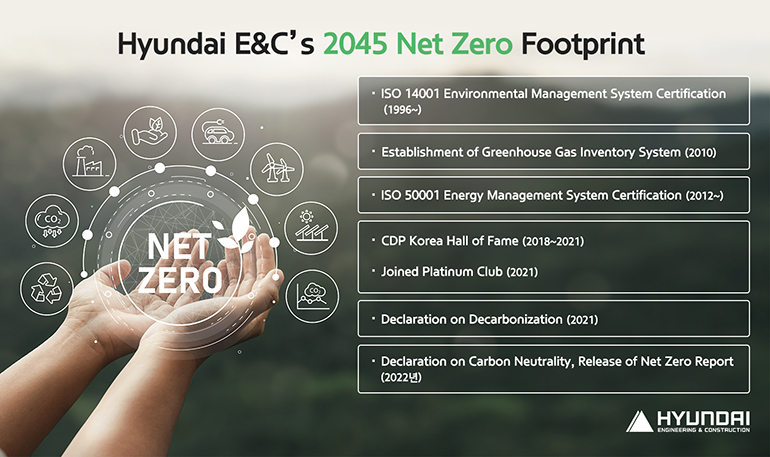
The solid foundation on which Hyundai E&C earned global recognition is its “environmental energy management strategy.” The company established green management strategy and goals to make a leap forward as “2050 Global Green One Pioneer.” Hyundai E&C, having declared its goal to achieve Net Zero emissions by 2045 on October 26, released a report titled <Global Green One Pioneer: Net Zero by 2045> which included vision and renewed commitment towards protecting our planet Earth.
G-OPIS Hyundai E&C’s Commitment to Net Zero Emission
In light of the deepening climate change crisis and shift towards energy transition, the responsibility and role of construction companies have become more important than ever. According to the International Energy Agency, construction companies contribute 0.5% to the total global carbon emissions, but 38% of the emissions come from the total value chain from production and transportation of construction materials to operation and disposal of finished buildings. In this situation, Hyundai E&C’s net zero strategy is creating a new wave in the construction sector. Based on the latest science and technology, the company has set carbon-neutral targets based on high standards of the initiative SBTi (Science Based Targets Initiative) to verify greenhouse gas reduction targets and established four major strategies that reflect the characteristics of the construction sector.

Hyundai E&C’s net zero strategy can be summarized as “G-OPIS”. G-OPIS is an acronym made by putting together the word “Green” and the first letters of “Operation‧Portfolio‧Investment‧Spread” and represents Hyundai E&C’s four strategies on carbon neutrality. It embodies a strong will of Hyundai E&C to expand its low-carbon business portfolio and lead the transition into a net zero society as a global leader. It plans to achieve Net Zero by 2045 while gradually reducing greenhouse gas emissions by 2030.
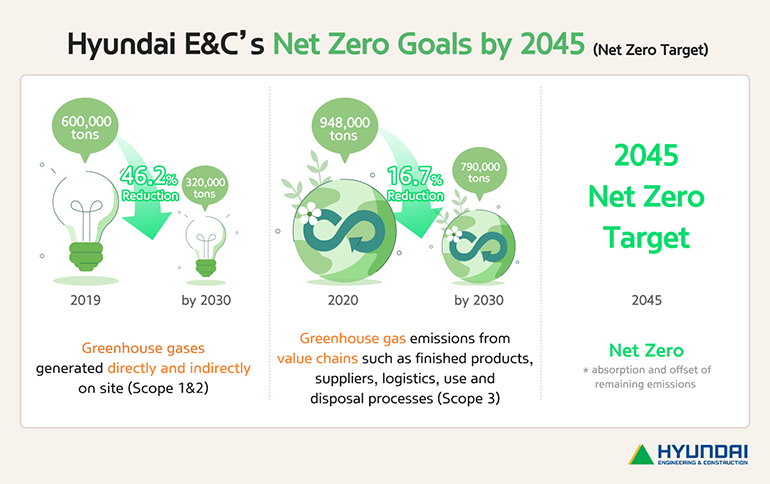
■ Green Operation
Use of Renewable Energy and Systematic Management of Greenhouse Gas Emissions For “Smart” Net Zero Strategy
The energy we use is mainly made by burning fossil fuels such as oil, coal, and gas. This is a significant amount, accounting for 87% of annual greenhouse gases emissions in Korea. Experts explain that reducing fossil fuel use and actively utilizing renewable energy will greatly help cool down the heated Earth. Renewable energy is energy made from non-depletable resources obtained from nature such as sunlight, water, and wind, and mostly generated by solar, hydro and wind power plants.

[ Hyundai E&C is expanding the use of renewable energy by installing solar panels on the roofs of on-site offices. ]
Hyundai E&C’s net zero transition begins with the construction sites, the very foundation of a construction company. First of all, the on-site office will be transformed. Starting next year, solar panels will be installed on the roofs to improve energy efficiency at on-site offices. The goal is to expand the use of renewable energy by self-producing electricity (self-consumption-based solar power generation). All business vehicles at domestic sites will be converted to green vehicles by 2030. In the mid-to long-term, Hyundai E&C plans to reduce gasoline use by applying electrified construction machinery. In addition, the company plans to systematically manage greenhouse gas emissions by automating the CO2 emissions collection system and subdividing the data aggregated at sites into smaller units.
Hyundai E&C is also seeking smarter carbon neutrality. In order to establish a low-carbon construction operation system, ▶ digital construction technology ▶ off-site construction (OSC) method, and ▶ new and renewable energy process technology were actively developed and introduced. Digital construction technologies such as Building Information Modeling (BIM), IoT, and Robotics reduce construction periods, increase productivity, and reduce carbon emissions during construction. Since June, Hyundai E&C has been realizing green construction by establishing a cloud-based BIM collaboration system at all sites of construction and housing.
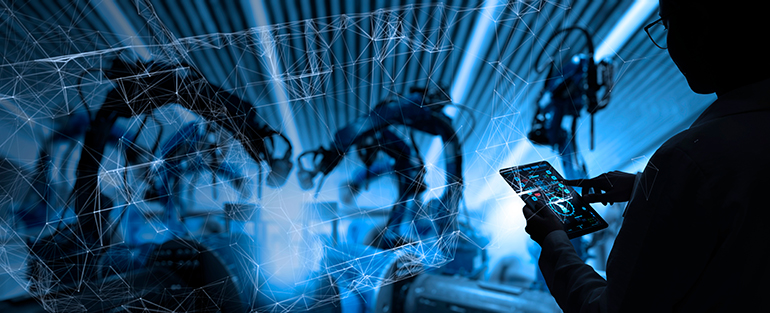
The OSC method of standardizing major construction materials, manufacturing them in a factory and then assembling them on site is comparable to assembling Lego blocks. This method, shifting the paradigm from the existing on-site construction to off-site construction, is effective for reducing waste and carbon emissions during construction. In addition, Hyundai E&C is securing a low-carbon construction system that can directly lower greenhouse gases by developing process technologies related to new and renewable energy. It plans to continue to strengthen its capabilities in low-carbon construction technology in line with its reputation as a “Hyundai, Enabler of Technology”.
■ Green Portfolio
Expanding Sustainable & Green Portfolio Based on EPC Competitiveness
As the low-carbon and renewable energy markets grow due to carbon neutrality, eco-friendly business has emerged as a keyword for companies. According to the International Energy Agency, the global renewable energy market will more than triple, from 29,989 GW in 2020 to 102,293 GW in 2030. Hyundai E&C is expanding its sector-based green portfolio based on its EPC competitiveness that has been accumulated so far. ▶ Civil engineering include green projects such as offshore wind power, water reuse, seawater desalination, soil purification, etc. ▶ In the construction and housing field, there are green construction projects such as zero energy building and green remodeling whereas ▶ in the plant sector, the company has set its direction to leverage its capabilities on low-carbon-based projects such as renewable energy, hydrogen plants, and CCUS, and renewable energy brokerage projects.
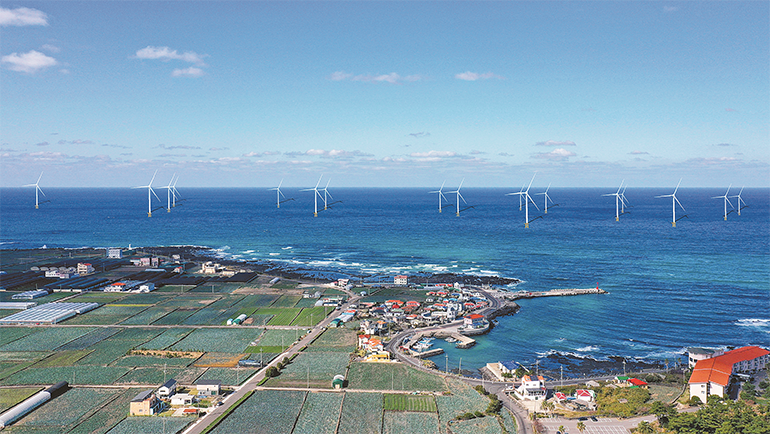
[ Hyundai E&C is expanding its renewable energy projects by carrying out the Jeju Hallym Offshore Wind Farm Project, the largest offshore wind power project in Korea. ]
In the civil engineering sector, the green portfolio has been expanded based on long years of expertise and technology. Hyundai E&C proved its ability to provide a total solution for solar power by carrying out everything from business development, EPC (engineering, procurement, construction), to O&M (operation & maintenance) of Seosan Solar PV Park, in 2019. Hyundai E&C has completed the Southwest Sea Maritime Wind Power Demonstration Complex, Korea's first offshore wind power demonstration complex, and implemented the Jeju Hallym Marine Wind Farm Project, the largest offshore wind power project in Korea, expanding its portfolio of new and renewable energy projects. Based on this, the company plans to expand its business portfolio as a renewable energy power brokerage (*PPA) operator and ensure stable supply of renewable energy for companies in demand.
*PPA (Power Purchase Agreement): A power purchase agreement is a system that allows businesses or households to sign a contract directly with renewable energy supplier to receive electricity.

Zero Energy Building refers to a building in which the total amount of energy consumed by a building added with the renewable energy created in the building becomes zero. It is evaluated that the closer the final amount of energy is to “0”, the higher the building energy independence. Hyundai E&C’s Hillstate Lake Songdo Complex I is the first energy-saving apartment complex in Korea that has obtained a building energy efficiency rating of 1++ and a zero energy building rating of Level 5 (energy sufficiency of 23.37%). It increased energy efficiency by applying passive (preventing external leakage of energy) technology to minimize energy consumption, active (green energy production) technology to generate necessary electricity and heating using solar and geothermal heat, as well as Smart BEMS (Building Energy Management System) developed independently by Hyundai E&C for the first time in the industry.
In recognition of its technology, it also won the Minister of Land, Infrastructure and Transport Award at the 2nd Korea Intelligent Building Competition. In addition, it has continued to implement green construction and housing projects such as AmorePacific's new HQ building, which received the “Highest Grade in Green Architecture” and "Grade 1 in Building Energy Efficiency," and LH headquarters' new building, which not only saved total energy but also optimized construction by applying BIM for the first time in Korea.
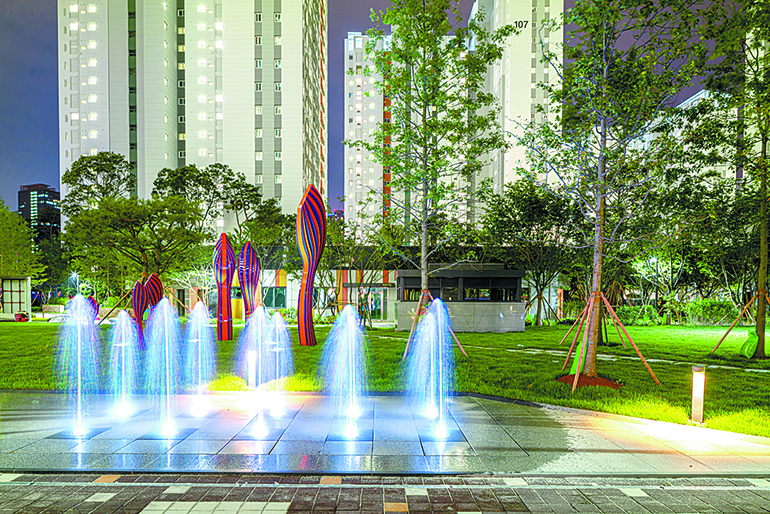
[ Hillstate Lake Songdo Complex I is an energy-saving apartment complex that obtained building energy efficiency Grade 1++ and zero energy building Level 5 for the first time in Korea's apartment complex category. ]
*Clean hydrogen, which has emerged as a key energy source in the era of carbon neutrality, is an area of particular interest to Hyundai E&C. Hydrogen is a key means of overcoming the limitations of renewable energy, which is heavily influenced by the weather and the natural environment. Hyundai E&C is planning a business that encompasses all stages from hydrogen production to storage, transportation, and utilization. The company, which completed the Boryeong Clean Hydrogen Project and recognized for its hydrogen plant *FEED (Front End Engineering Design) design capability, is laying the foundation for the first commercial clean hydrogen production base in Korea and abroad in June this year.
*Clean hydrogen: Clean hydrogen means it emits significantly less carbon dioxide (blue hydrogen) or does not emit any carbon dioxide (green hydrogen) in the process of hydrogen production.
*FEED engineering lays the foundation for pre-EPC (Detailed Engineering, Purchasing, Construction) contract construction. It is an important step to establish the basis for construction by setting the criteria for calculating quotations. Since a high level of project experience and understanding of the process are required, signing FEED can help the company gain advantage in EPC orders.
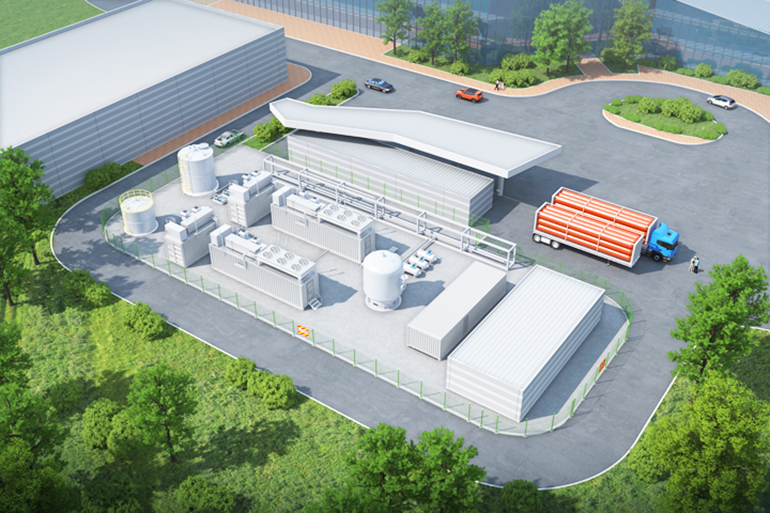
[ The water electrolysis-based hydrogen production base in Buan, Jeollabuk-do, is the first commercial clean hydrogen production base in Korea. ]
Hyundai E&C is also committed to Carbon Capture Utilization and Storage (CCUS), the most realistic way to achieve carbon neutrality. CCUS collectively refers to the technology of "capturing", “utilizing”, or “storing” carbon, generated during fossil fuel combustion and specific processes. It is a key technology for blue hydrogen production, which is essential for realizing a hydrogen society. Hyundai E&C is developing “hybrid-based CO2 capture and liquefaction process technology for blue hydrogen production”. It plans to develop a process to capture more than 100 tons of carbon dioxide a day and gradually apply it to natural gas plants or various workplaces that produce blue hydrogen.
■ Green Investment
ESG bonds, Driving Momentum for Net Zero Strategy
What are the criteria for a good company? Gone are the days when companies were simply evaluated in terms of their revenue size or welfare benefits provided to their employees. Today, “Environment, Social, and Governance” have become the new standards for business operations.
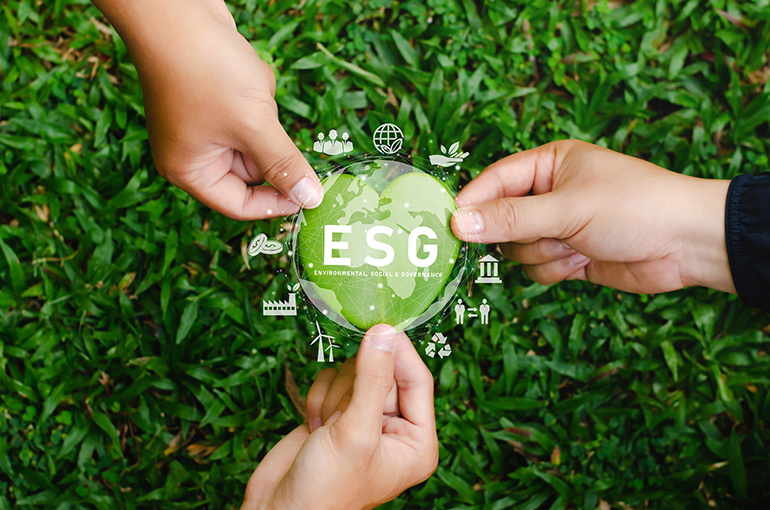
Hyundai E&C is seeking to issue ESG bonds in the mid- to long-term to secure the driving force for realizing carbon neutrality. ESG bonds refer to bonds issued to raise funds related to socially responsible investments. It is an opportunity for companies to prove their green management and eco-friendly portfolios based on sound financial structures and to participate in creating a better environment and society. Not all companies can issue ESG bonds just because they seek to achieve common good. The use of ESG bond proceeds is limited to eco-friendly sectors such as carbon reduction, renewable energy, hydrogen cars, and electric vehicles as the investment destinations are transparently disclosed to prevent *greenwashing.
*Greenwashing: It refers to the act of promoting corporate business as being ecological, whereas in fact, it is not eco-friendly.
Hyundai E&C expects ESG bonds to serve as a solid foundation for its on-going green projects. Based on this, it plans to develop green technologies and increase sustainable products to achieve substantial greenhouse gas reduction. It is also against this backdrop that the company has set a goal of significantly increasing the share of its sales coming from sustainable products from 37.41% in 2021 to 60% in 2030. Hyundai E&C will select ESG bond investment targets based on the EU Green Taxonomy and the Korean Green Taxonomy, and set sustainability goals linked to ESG management strategies. It will also transparently disclose project progress and details to increase confidence.

Meanwhile, the UNFCCC created carbon credits to limit carbon emissions. It is a system that allows companies to use greenhouse gases within the allocated range and trade the lacking or surplus emissions in the market.
Unlike the government-regulated Compliance Carbon Market, the Voluntary Carbon Market allows companies, with no obligation to reduce their greenhouse gas emissions, can trade the greenhouse gas emissions reduced by external projects(carbon credits) in the form of a certificate. Hyundai E&C will reinvest the proceeds from trading carbon credits in domestic and foreign renewable energy generation, green building materials development, and CCUS technology development to contribute to global carbon reduction targets.
■ Green Spread
A Relay Race for Carbon Neutrality
Hyundai E&C’s genuine care for carbon neutrality begins with encouraging and caring for its partners. Hyundai E&C, which developed the “Sustainable Management Evaluation Index for Partners” for the first time in Korea in 2014, regularly evaluates and manages environmental, social, and economic risks of its partners. In particular, in the environmental risk evaluation, the amount of greenhouse gas emissions and reduction by partner companies is evaluated and classified by characteristics. Separate measures are being established and managed according to the characteristics so that effective reduction can be achieved. Furthermore, Hyundai E&C is also striving to create carbon-neutral synergy with its partners by developing low-carbon materials with building material companies.
Hyundai E&C’s strong commitment to carbon neutrality is based on the consensus of management and staffs. All members of the organization, who have put their heads together to reduce carbon emissions, such as organizing green campaign to encourage small but important habits in daily life, and a net-zero idea contest, have recently been practicing carbon neutrality through “Volunteer to Care for Companion Trees and Afforestation Campaign.” It is an environmental volunteer activity for employees to grow companion trees for four weeks and donate them to the underprivileged, and then the trees will be planted in the forest in proportionate number to the donated trees.

[ Hyundai E&C employees donate their companion trees that they had cultivate for four weeks to the underprivileged. Trees will be planted in the forests, in a proportionate to the total number of donated trees. The photo shows Dwarf umbrella tree (left) and Chamaedorea elegans, which will be grown by Hyundai E&C members. ]
It is also focusing on social contribution activities to reduce carbon emissions. The energy efficiency improvement project “H-Green Saving,” which has been underway since last year, is a project to replace lightings in social welfare institutions with high-efficiency LEDs in Seoul. Solar panels are installed in idle spaces to support the use of new and renewable energy. The initiative is expected to reduce the burden of household operating expenses for the vulnerable and contribute to reducing greenhouse gas emissions. Hyundai E&C will be recognized for its significant savings of greenhouses gases in the form of carbon credits, after undergoing the greenhouse gas reduction evaluation by Korea Energy Agency. The proceeds secured from carbon credits will be donated to the Seoul Energy Fund to be used for energy education projects for youth in the environment sector.

Hyundai E&C’s Ceaseless Efforts to Achieve Net Zero by 2045
In order to practice ESG management, in 2020, Hyundai E&C launched a Sustainability Management Consultative Body under the Corporate Governance and Communication Committee, which consists of all outside directors. The CFO-led Sustainable Management Consultative Body consists of in-house organizations with expertise and execution ability to monitor pending issues related to climate change on a quarterly basis. The governance system to achieve carbon neutrality has been established as related information is reported to the board of directors, a decision-making body, through the Corporate Governance and Communication Committee. In addition, in May 2021, for the first time as a construction company, Hyundai E&C established a 4P (Prosperity, Planet, People, Principle)-based sustainable management system by reflecting ESG information standards of the World Economic Forum. These efforts helped the company to obtain Grade A in the Korea Corporate Governance Service (KCGS) ESG comprehensive evaluation for the fourth consecutive year.
“Climate change is the most important task for mankind to solve, and carbon neutrality is the starting point for a sustainable future” This is the first sentence from the <Global Green One Pioneer: Net Zero by 2045> report’s “The Net Zero Message of Hyundai E&C Board”. Hyundai E&C will lead the green construction ecosystem based on the construction competitiveness accumulated in various business areas. Everyone’s attention will be geared towards Hyundai E&C, which never stopes to lead green construction market and become a pivotal player in a decarbonized society.

